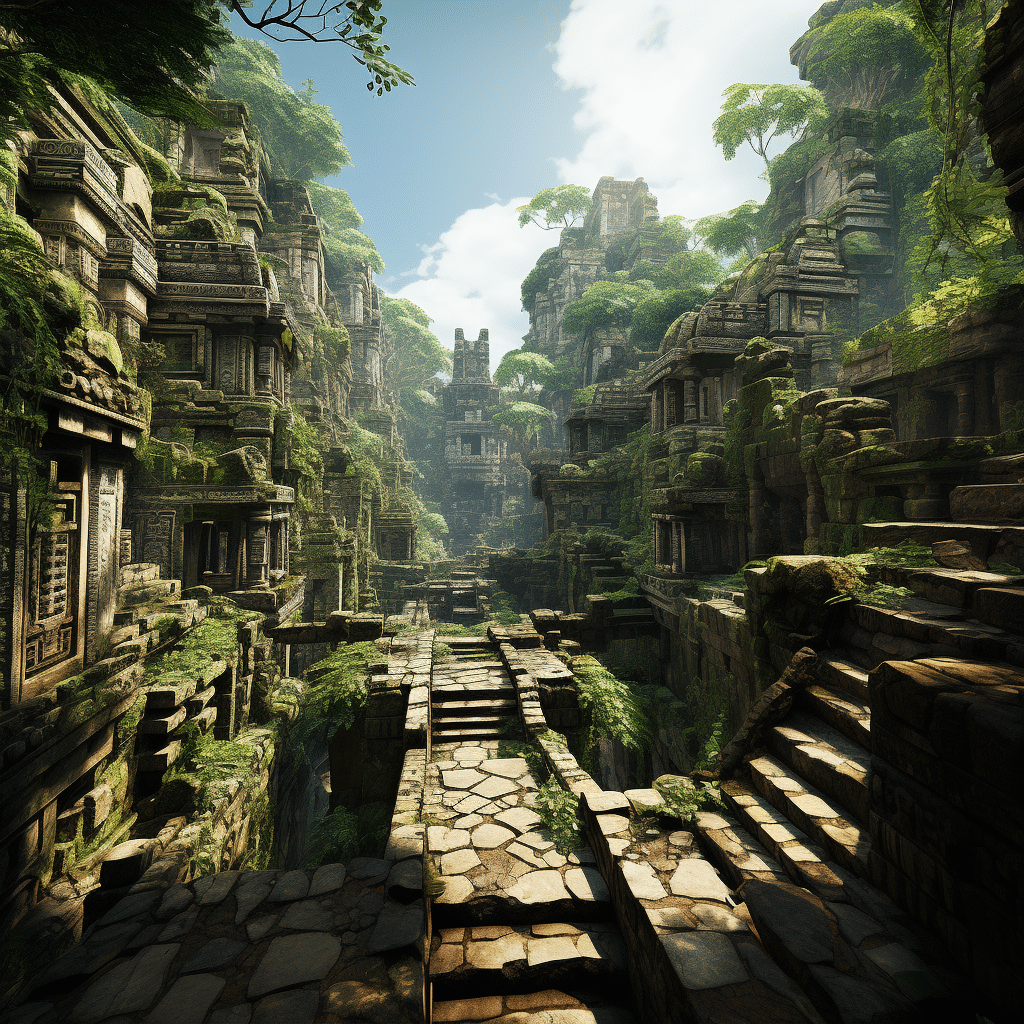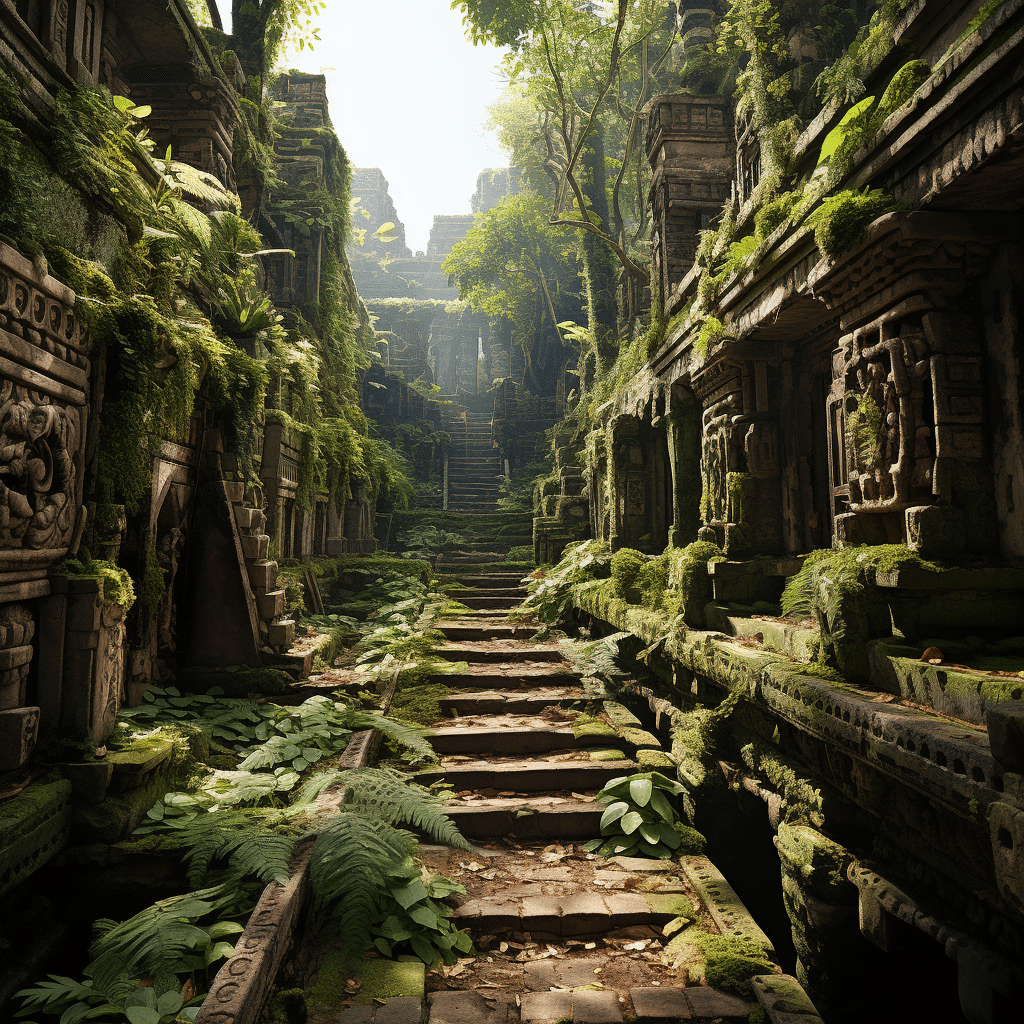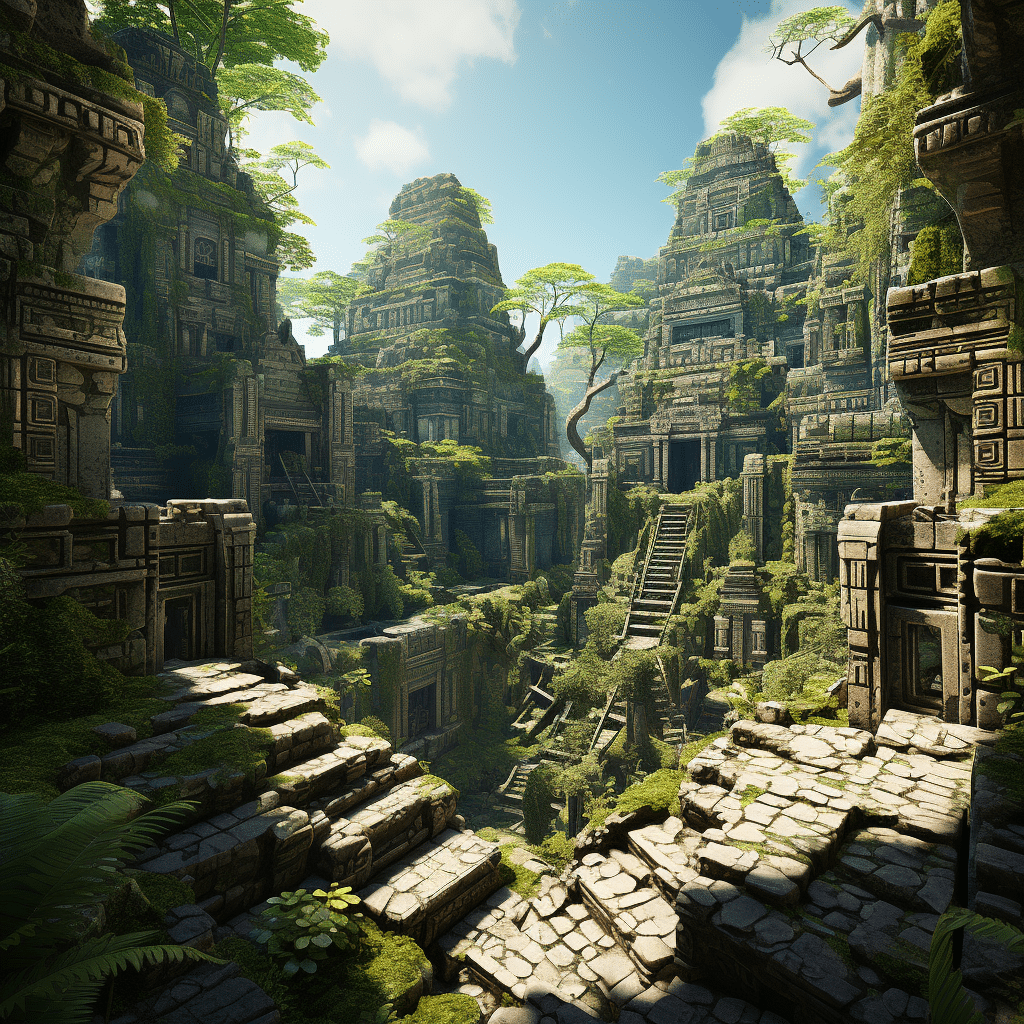Journey with me, if you will, through the story of a civilization whose whispers can still be heard amidst the ruins – a tale stitched into the very fabric of the Mesoamerican tapestry. The Mayan ruins are not merely relics; they are time capsules, immortalizing an enigmatic culture that continues to intrigue scholars and travelers alike. Let’s walk the stones of ancient plazas, climb the steps of titanic temples, and bask in the shadow of the Maya – a people who flourished, faltered, but forever left their mark on human history.
Exploring the Enigma of Mayan Ruins: Unearthing the Past
The whispering leaves of the dense jungle can nearly tell the tales themselves – tales of the ancient Maya, a civilization that traces its beginnings to around 2000 BCE and reached unrivaled sophistication in the Americas long before the Spanish conquest. Forged from the loins of Mesoamerica, the Maya were astronomers, mathematicians, and devout believers in a cyclical nature of time. So profound was their influence that today’s visitors can’t help but feel a frisson of awe as they brush fingertips over etched hieroglyphs.
Recent digs have only fueled the flame of fascination, unearthing ceramics and stelae that pull the ancient Maya from the realm of the unknown into vivid reality. Every discovery, a piece fitting into the grand jigsaw of history, reveals more about the Mayas’ livelihood, their wars, gods, and the rhythm of their daily life.

Traversing the Depths of Time at Tikal: A Majestic Mayan Marvel
Plunge into the heart of Guatemala’s jungle, and Tikal emerges – a testament to Mayan grandeur. With its towering temples slicing through the canopy, Tikal was more than a city; it was a beacon of power and knowledge. From the intricate hieroglyphics to the imposing Temple IV, every stone sings a silent ode to the sky-gazers and architects who once thrived here.
The Mayans’ understanding of the cosmos was not just a scholarly pursuit; it was the heartbeat of their culture, and Tikal’s layout – aligned strategically with celestial bodies – whispers of their astronomical prowess. To visit Tikal is to stand where kings and commoners alike marveled at the heavens, where rituals were steeped in the dance of stars.
| Site Name | Location | Notable Features | Period | UNESCO Status | Visitor Info |
|---|---|---|---|---|---|
| Chichen Itza | Yucatan, Mexico | El Castillo Pyramid, Ball Court, Temple of the Warriors | 250-900 A.D. | World Heritage Site (1988) & New Wonder of the World | Accessible from Cancun; best visited early to avoid crowds |
| Mayapan | Yucatan, Mexico | Similar layout to Chichen Itza, but smaller scale | 1200-1450 A.D. | — | Open to visitors; less crowded |
| Tikal | Peten, Guatemala | Temple IV, Grand Plaza, Temple of the Great Jaguar | 250-900 A.D. | World Heritage Site | Day trips possible; overnight stays recommended |
| Ek Balam | Yucatan, Mexico | The Acropolis, Oval Palace, well-preserved sculptures | 100 B.C.-1000 A.D. | — | Located near Valladolid; often combined with a visit to Cenote X’Canche |
| Xunantunich | Cayo, Belize | El Castillo pyramid, friezes depicting Mayan mythology | 600-1000 A.D. | — | Accessible by a hand-cranked ferry across the Mopan River |
| Xel-Ha | Quintana Roo, Mexico | Partly submerged ruins, a unique natural aquarium | 200-600 A.D. | — | Often combined with eco-park visits; great for snorkeling |
| Muyil | Quintana Roo, Mexico | Part of Sian Ka’an Biosphere Reserve, a lagoon system | 300 B.C.-1500 A.D. | Borders a World Heritage Site | Less touristy; can be combined with eco-tours |
| Copán | Western Honduras | Detailed stone sculptures, hieroglyphics, and stelae | 400-800 A.D. | World Heritage Site | Good infrastructure for tourism; museums nearby |
Calakmul: The Ancient Superpower Amidst the Mayan Ruins
In the shadows of Tikal lies Calakmul, another titan of the Maya world nestled in the Mexican jungles. Here, the air thrums with the echoes of a once-mighty kingdom, a capital in ceaseless strife for dominance over the Maya lowlands. Calakmul wasn’t just a city; it was an empire’s nerve center, where commerce, art, and politics intertwined in the lowland rainforest.
In the growing jigsaw of Mayan history, Calakmul’s colossal structures and the latest unearthed glyphs provide missing corners – glimpses into the complexities of Mayan diplomacy and warfare that shaped an empire.

Copán: Aesthetics and Artistry among the Mayan Ruins
Venture to Honduras and you’ll find Copán, a testament to the flourish of Mayan creativity. Unlike the stoic grandeur of Tikal or Calakmul, Copán resonates an air of elegance and artistry. Here, intricately carved stelae and altars tell stories of ancient rulers, while the Hieroglyphic Stairway holds the longest script of Mayan literature in stone.
Through the lens of luxury, Copán whispers stories of a cultured people – a civilization that prized beauty as much as it venerated the gods. Elite travelers swapping their cycling shorts for explorer hats will appreciate the finesse of the stone sculptures, a craft that to this day remains indisputably peerless.
Chichen Itza: The Iconic Emblem of Mayan Ruins
Speak of Mayan ruins, and murmurs of Chichén Itzá follow. Chichén Itzá is not just a ruin; it’s a cultural symphony – one where the Mayan and Toltec spirits dance together amidst colossal pyramids and sprawling ball courts. A UNESCO World Heritage site and a New Wonder of the World, the Kukulcan Pyramid alone is a magnum opus of astronomical observation, where light and shadow play out the tale of the serpent deity during equinoxes.
Tourists today, keen to swap the neon lights and hubbub of Cancun for the serene echoes of a past civilization, find in Chichén Itzá an endless canvas of intrigue, a place where the past bleeds into the present, sculpted not just in stone but in the very psyche of Yucatan.
Palenque: Decoding Royal Secrets of the Mayan Ruins
In the enveloping warmth of Chiapas, Mexico, Palenque lays bare the secrets of Mayan royalty. The fine architecture, less imposing than Tikal but no less magnificent, reveals an intimate account of lineage and legacy through the Temple of Inscriptions, where the sarcophagus of Pakal the Great lies – his visage forever preserved in jade and stone.
Excavations continue to tease out the complexities of Mayan politics and rituals, connecting the dots between once-mighty dynasties and their divine claims to rule. Palenque, regal and mysterious, holds its cards close, revealing only teasing glimpses of ancient intrigue to those who traverse its sacred grounds.
Uxmal: Reflecting Religious Zeal in the Mayan Ruins
Head north from Palenque and you’ll be graced by the geometrical marvels of Uxmal. Here, the cadence of religious fervor is etched into every facade, every pyramid echoing with ceremonies past. The Governor’s Palace, with its intricate lattice-styled façade, and the Pyramid of the Magician, with its rounded edges soaring toward the heavens, narrate tales of sacred rites and celestial alignment – a homage to the gods that governed every aspect of Mayan existence.
Research into the complexities of Uxmal’s design indicates a society grappling with nature’s caprices – a testament to the Maya’s unique blend of science, religion, and artistry.
Caracol: The Astronomical Genius of the Mayan Ruins
Journey to Belize and Caracol becomes the focal point of Mayan ingenuity. This colossal settlement redefines the term ‘astronomical genius’ with its E Group of buildings masterfully constructed to observe and celebrate the solstices and equinoxes. Caracol is not a silent ruin, but rather a megaphone broadcasting the Maya’s celestial obsessions.
Alignments of ancient structures here coincide with key solar events, each stone a witness to a civilization that lived by the sun, moon, and stars. Even a casual visitor cannot help but marvel at the level of sophistication achieved with the most rudimentary of tools.
Conservation Efforts: Protecting the Legacy of the Mayan Ruins
Preserving the past demands more than reverence; it requires action. Today, conservationists and historians work hand-in-hand to prevent the encroaching hands of time and human interference from silencing the echoes of the Maya. Innovative technology and collaborative efforts are reshaping how we safeguard these ruins for future generations to ponder and learn.
From 3D printing lost fragments to reforesting surrounding jungle, each step marks a commitment to the longevity of the Mayan legacy, ensuring the whispers of the ancients are not lost in the cacophony of modernity.
Experiencing the Mayan Ruins: A Guide for Modern Explorers
Modern explorers, hungry for a slice of the past, can embark on a journey through quintessential Mayan cities – Mayapan, Xunantunich, Xel-Ha, Muyil, and more. For those with a taste for luxury, options abound to tour these gems with the extravagance of a Mayan noble—think sumptuous accommodations and exclusive access to sunrise temple tours or moonlit rituals.
Sustainable tourism practices are becoming the gold standard, propelling local economies while protecting these hallowed grounds. Visitors contribute to a circle of preservation – experiencing the ruins first-hand and supporting the efforts to keep this history alive.
A Living History: The Mayan Influence on Contemporary Culture
The saga of the Maya is not confined to stone and jungle. It thrives in the modern tongue, in the celebrations and daily practices of the millions of Maya descendants who carry the torch of their ancestors. Efforts to document and integrate Mayan heritage are an ongoing chapter in the narrative of a people who refuse to be relegated to the annals of time.
Within the intertwined roots of Central America, one finds a culture reverberating with the strength of its past – a civilization that, despite facing the abyss, reaches out through the ages to remind us: we are here, we endure.
Conclusion: The Eternal Echo of the Mayan Ruins
So, there we have it – an odyssey through time, a chronicle of the Maya, sculpted not just in limestone and jade but in the cyan of the skies they worshiped and the fertile soil they tilled. The Mayan ruins stand as sentinels, commanding our attention, demanding that we listen – lest we forget the enduring impact they’ve had on history, science, and culture.
From Tikal to Chichén Itzá, these ancient cities, once cradles of knowledge and power, continue to unravel the tapestry of human history. They offer lessons in resilience, wisdom, and humility; poignant reminders of the cyclical nature of time and civilizations. They urge us to ponder the horizon of our own legacy, long after the final chapter of our history has been written. Rise and fall, build and crumble – but above all, endure. This is the lesson of the Maya – a lesson etched in stone and whispered by the timeless wind.
Discover the Mysteries of Mayan Ruins
Picture this: you’re walking where ancient shamans once conducted rituals, and warriors clashed! The Mayan civilization was full of surprises, much like learning the unexpected twists in comedian Mitch Hedberg’s life; their history is both intriguing and complex. Delve into these ruins, and you might feel as though you’ve stepped onto a movie set, maybe even one where Sam Rockwell could be filming his latest epic. It’s not just the towering pyramids and sprawling cities that captivate—the ingenuity of the Mayans is evident in the very stones that have withstood the ravages of time.
Now, here’s a fun-sized morsel to chew on: while the average Mark Wahlberg height might be a snappy detail to know when comparing Hollywood stars, Mayan pyramids were designed with the celestial heights in mind. These structures were aligned with astronomical events, such as solar eclipses and solstices, underscoring the Mayans’ sophisticated understanding of astronomy long before the telescopes of Europe pointed towards the heavens. And while it’s quite easy to check what time it is in Austria with a quick click, the Mayans had to rely on intricate calendar systems, the accuracy of which still astonishes experts today.
What’s more, the way we unwind in our modern era, maybe picking the perfect Naturium body wash for a spa day, the Mayans also had their own methods of relaxation and ritual. Some ruins, like those you’ll find on your things To do in Tulum list, reveal remnants of steam baths called temazcals, which were used for both healing and ceremonial purposes. Although this fact might seem on the fringes like the quirky musings of Elle Duncan, it actually provides a fascinating peek into the daily lives of the Mayan people.
So, while the Mayan ruins continue to be a subject of deep historical significance, they also offer every visitor a generous slice of awe. From their function as astronomic clocks to leisurely retreats, weaving through these ruins is akin to reading a rich, multi-layered story. And just when you think you’ve learned all there is, you’ll find another hidden nook that sparks a whole new round of curiosity, much like peeling back the layers of a good book. After all, exploring the secrets of the past is always in style, wouldn’t you agree?























